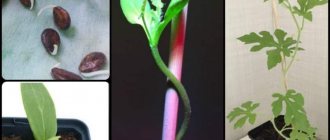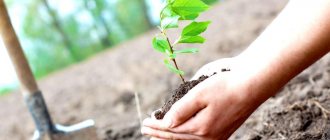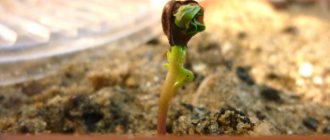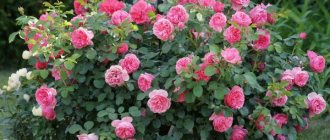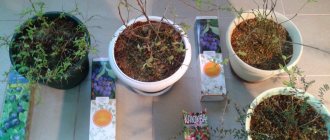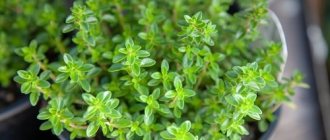Preparing seeds and soil
In warm regions (at the latitudes of Saratov and Kursk and further south), there are usually no problems with growing peaches from stones. It is enough to bury a few seeds from ripe peaches in the ground right in the garden in the fall. At least some of them will definitely sprout, and over the next season the seedlings will grow up and be ready for planting in a permanent place. In the middle zone, this technique may not work, so many gardeners prefer to grow peaches from seeds in pots indoors. In any case, both planting material and soil should be properly prepared.
First of all, you need to decide which fruits you can take seeds from for planting. You should not use store-bought peaches for this: perhaps sprouts will appear after planting, but it is unknown what will come of them. As a rule, fruits from southern trees, often brought from distant countries, are sold in stores and markets. Firstly, it is not clear whether they had time to finally ripen on the branches. Secondly, most likely they were taken from grafted trees. Therefore, the probability of obtaining a peach seedling of the same variety to which the fruit you liked belonged to is minimal.
For planting with pits, you should choose peaches that grew on own-rooted trees, preferably zoned ones - for example, those that successfully bear fruit “at your neighbor’s dacha.” Only in this case, in a few years, you will be able to enjoy the same fruits from your own harvest. Peaches must be fully ripe, or even better, overripe, otherwise the germination rate of the seeds will be low. They must not contain traces of rot or mechanical damage. Statistics show that only 25-30% of the seeds germinate, so you should stock up on a sufficient amount of ripe fruit.
For autumn planting, seeds taken from fruits must:
- clean thoroughly from any remaining pulp;
- rinse with warm water;
- dry at room conditions.
If planting is postponed until spring, such seeds are stored in a dry place and then soaked for 8-10 hours in rain or snow water. In autumn, the seeds are planted shortly before the first frost; in the spring in open ground in May-June, and in an apartment (in pots) in March-April.
When growing peach indoors, you can use any universal soil mixture as soil. It is permissible to simply take garden soil, adding almost the same amount of humus and half as much of the loosening component (perlite, vermiculite, etc.). To eliminate unwanted problems (pests, fungal spores), the soil is disinfected in the usual way (steaming in the oven or pouring a pink solution of potassium permanganate). When sowing seeds in the garden, dig up the soil with the addition of organic matter and loosen it well to 8-12 cm.
Which trees do not peach grow with?
The trees in our gardens do not grow entirely harmoniously - most of them are constantly in a struggle for light and moisture. A delicate peach is not able to compete with them on equal terms. Therefore, experienced gardeners try not to plant it with such trees:
- apricot;
- cherries and sweet cherries;
- pear;
- Apple tree;
- Walnut.
Not only neighbors are important for the development of a peach, but also the plants that grew on the site before it. He will definitely feel traces of strawberries, strawberries, peppers, eggplants, tomatoes and potatoes. They often leave behind infections that other trees cope with, and the peach dies before our eyes.
Germination methods
To germinate a peach pit, you can deal with it in different ways, although when sowing in the garden in the fall, no special actions are usually required. So, traditionally, the seeds are planted whole, without disturbing their dense shell. But there is a technique for planting with the nucleolus; some gardeners prefer it, although they need to be more careful.
Under natural conditions, peaches grow from a whole pit, but before that they are exposed to low temperatures in the winter. Similar conditions should be created in the case of home sowing: before sowing, it is necessary to provide the seeds with a low temperature for some time (carry out artificial stratification). It is also necessary in the case of spring sowing directly in the garden.
How to cover for the winter
Although new peach varieties can withstand frost well, they can harm young plants. Therefore, you need to take care of their protection in winter:
- Dig up the soil around the plant and water it. This will be beneficial for peach roots.
- Use preparations (fungicides, for example) to spray the seedling to prevent diseases and pests.
- Cover the area under the crown of the peach tree with mulch (sawdust, for example).
- Wrap the trunk of a young tree with burlap, and the crown with agrofibre or craft paper.
Find the best fruit tree seedlings with high winter hardiness on the Becker store website.
We only have high-quality planting material for your garden. Author: Natalya Palamarchuk
Planting in open ground with a whole shell
In the southern regions, the seeds undergo natural hardening, since they are simply planted in the garden in the fall. This method of stratification allows you to obtain the strongest specimens that are resistant to the vagaries of the weather. The sowing depth is 5-10 cm, although some gardeners believe that it is possible to plant shallower. However, this depends, first of all, on temperature and humidity conditions. Usually the crops are not even watered, and if hot, dry weather sets in in the spring, seeds planted too small may die. Leave 10-15 cm in the row between them. The school is mulched with dry bulk material (for example, pine needles).
In the spring (usually in May), sprouts appear, which by autumn turn into ready-made seedlings. All care for them during the summer consists of removing weeds, shallow loosening of the soil, and in case of dry weather, watering. No additional fertilizing is required. If fungal diseases of stone fruits are widespread in the region, you will have to carry out several preventive sprayings with suitable preparations - for example, Ridomil Gold.
The best specimens are planted in a permanent place in the fall, or better yet, next spring, in pre-prepared planting holes. In 2-3 years you will be able to taste the first fruits.
The seeds can sprout even in the second or even third year after planting. You shouldn’t be surprised when you see shoots, for example, in a garden bed with carrots.
Residents of the southern regions rarely engage in artificial stratification of seeds, but in the middle zone this is a common technique. The process is carried out at home, it can be controlled. In practice, stratification (keeping the seeds in the refrigerator) and germination (up to the appearance of sprouts) are often combined. Work begins at the very end of winter.
The process consists of the following steps:
- Clean, damp sand is poured into a small container (plastic, wooden, clay).
- The seeds are placed in it, slightly deepened.
- The container is covered with polyethylene with small holes for “breathing”.
- It is placed on the bottom shelf of the refrigerator (or in the basement).
- The container is systematically inspected: the sand should always be slightly damp.
Pecking at a temperature of +1...+5 degrees occurs after about three months, that is, by the onset of the warm season. Seeds with small sprouts are carefully transplanted into open ground. If the sprouts appear ahead of time, you will have to plant the seeds in a pot and grow the seedlings on the windowsill. It is not always possible to meet the deadlines correctly: they depend both on the temperature in the refrigerator and on the type of peach.
Tree care
To get a quick harvest, peach requires proper care.
Watering
The young seedling requires regular watering. But at the same time, it should be moistened only after the tree trunk circle has dried. If there is excess moisture, the roots of the plant rot.
Fertilizer
When planting using a planting hole, the peach does not require fertilizer for the first 3 years. Then you should give fertilizers 2 times a year: in the spring, after leaving the hibernation, and in the fall (in September-October).
Trimming patterns and timing
Peach trees produce abundant growth. They need to be pruned in the spring (sanitary, thinning procedures) or in the fall (formative, sanitary).
It is important to consider: fruit buds are formed on the side shoots, therefore, when forming cutting, the central conductor must be constantly shortened. This will stimulate the growth of side branches and make it easier to care for the tree.
Treatment against pests and diseases
To prevent diseases, it is recommended to carry out preventive spraying. The first is done in early spring. Then - according to schedule. At the same time, weeds should be pulled out, anthills should be removed, and plant residues should be burned.
Shelter for the winter
Only in regions with positive average winter temperatures can peaches overwinter without shelter. In other places, the trunk circle should be mulched with peat, sawdust, shavings 20-25 cm thick. It is recommended to tie the trunk with spruce branches or mineral wool. This measure will protect the plant from damage by hares.
To prevent freezing and cracking of wood on the north and northeast sides, it is recommended to install a screen made of plywood, slate or plastic. It will protect from cold winds.
Peach from the pit in a pot
Some gardeners, especially not in the southernmost regions, immediately decide to grow peach seedlings in pots. This is not the most correct approach: often peach trees grow up pampered, are easily affected by diseases, and react poorly to the vagaries of the weather.
This method is convenient because until the peach is transplanted into open ground, its growth can be constantly monitored. True, it is difficult to grow a real seedling at home, so its cultivation is still carried out in a school in the garden. For sowing seeds kept for several months in the refrigerator (stratified), any cups or pots with a capacity of 0.3 liters or more with drainage holes are suitable.
In them:
- Pour fertile soil mixture and water it with melt water.
- Press the seeds into the soil to a depth of 1 cm. In order not to be mistaken about where exactly the sprout will come from, lay them flat and not on the edge.
- Cover the pots with glass or film and place in a warm place (with a temperature not lower than room temperature).
- Ventilate the contents of the pots daily and moisten the soil if necessary.
After the sprouts appear, the optimal temperature during the day is 23...30 °C, at night about 20 °C. The lighting should be strong. Caring for seedlings consists of watering (as the soil dries) and fertilizing with complex fertilizer every 2 weeks. With the arrival of real summer, they are transplanted for growing into a schoolhouse according to a 20 x 30 cm scheme. Planting is carried out by transferring them into previously prepared holes, watering them well and mulching them. During the summer, water and remove weeds. For the winter, the school is covered with spruce branches and spunbond, building something like a hut. Not all seedlings will survive the winter. Those that pass natural selection can be planted in a permanent place in the spring.
Germination of seeds with extraction of seeds from the shell
It is believed that it is possible to obtain shoots from nucleoli mechanically extracted from seeds faster than without destroying the shell. You should not expect a big gain in time, and planting bare seeds in open ground is dangerous. However, there are supporters of this approach.
It consists of the following:
- The dried seeds are carefully split (with a knife, hammer, vice, or any other method). It is important that the nucleolus is not damaged.
- The bare seed is kept in warm water for 2-3 days to swell, changing it periodically.
- Plant the seeds in pots (one at a time), deepening them by 1-2 cm.
- Cover the pots with glass or film, which is lifted daily for ventilation.
The film is removed after the sprouts appear. Further care for seedlings is the same as when planting whole seeds.
Basic mistakes
Failure can await the gardener at every step, but usually, if the necessary conditions are met, there are no problems with growing peach seedlings from stones.
Common mistakes are:
- incorrect choice of fruit (immature, taken from a grafted tree, etc.);
- insufficient washing of the seed (can lead to its rotting);
- poor-quality soil (the presence of fungal spores in it is especially dangerous);
- insufficient stratification time;
- excessive depth when sowing;
- non-compliance with temperature and humidity conditions during cultivation;
- premature planting of seedlings in open ground.
Sometimes when growing peach seedlings in a schoolyard, the gardener does not notice fungal diseases of the seedlings; If not treated with fungicides, they die quite quickly.
Growing a peach from a pit in warm regions is not difficult: the operation is often described with the words “planted and forgotten,” and the seedling grows almost without care. In the middle zone, this process requires accuracy and some effort.
